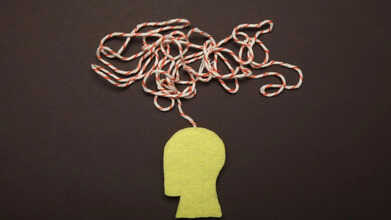- Health Conditions A-Z
- Health & Wellness
- Nutrition
- Fitness
- Health News
- Ayurveda
- Videos
- Medicine A-Z
- Parenting
- Web Stories
This Beauty And Makeup Favorite Item Could Lead To Blindness

There are many different aspects of beauty, whether it is skincare, haircare, makeup or any other beauty applications to achieve the kind of look you want. A lot of these routines are centered around our face; hence one must be careful not to hurt one's eyes, inhale some chemicals or even inject any product as they can cause harm to our health. For a few years now, many people have been opting for eyelash extensions or fake eyelashes to complete their beauty routine. These are done by professionals and while they do ensure safety, things can certainly go wrong, affecting your eyesight.
Dr Saurabh Sethi, a US-based doctor trained at Harvard University had warned us about a common beauty product: eyelash glue. He explained that some brands of eyelash glue may release a dangerous chemical that could have serious health consequences, including, in rare cases, blindness. While many people may be focused on the tools used, and how it can hurt your eye with one wrong move, the glue used can also be a big reason for hurting your eye health.
Chemical Culprit: Formaldehyde
In an Instagram video, the doctor explained that certain eyelash glues can release formaldehyde, a chemical also used to preserve bodies. He cautioned that while fake eyelashes are increasingly popular, the adhesive often contains this chemical. Formaldehyde can lead to allergic reactions, thinning, and even permanent loss of natural eyelashes. The doctor further stated that in very rare instances, it could even result in blindness. To reduce this risk, he advises either avoiding fake eyelashes or opting for formaldehyde-free adhesives.
Why is Formaldehyde in Eyelash Glue?
Experts explain that formaldehyde helps make lash glue last longer and stick better. However, even in small amounts, this chemical can trigger problems like shortness of breath, headaches, and skin irritation.
A 2022 study published by the American Contact Dermatitis Society found that a significant number of eyelash glues contained formaldehyde. Specifically, 75% of 20 professional products and four out of 17 consumer glues released the chemical. Surprisingly, only two of the consumer glues actually listed formaldehyde as an ingredient.
Cyanoacrylate Connection
According to a lash retailer, Lash Base, the main ingredient in all lash adhesives is cyanoacrylate, which is made from formaldehyde. They state that after cyanoacrylate is formed, the lash adhesive goes through a purification process to remove excess formaldehyde. This process purifies the glue, making it safe for use and leaving only trace amounts of the chemical behind.
Given these warnings, it's always wise to be cautious and consider the ingredients in your beauty products.
Fake Eyelash Safety Guidelines
The American Academy of Ophthalmology explains different nuances that could entail how safely your eyelashes are being installed. Here are some points you must keep in mind when getting eyelash extensions.
Why Infections Happen
Infections can pop up if the salon isn't super clean. Also, imagine sharp tools near your eye – if something slips, it could hurt you. So, hygiene and careful application are super important for your eye's safety.
Allergic Reactions to Glue
Some lash glues have chemicals like formaldehyde, which can cause an allergic reaction. This might make your eyes hurt, itch, turn red, or swell up. It's a big deal, especially since these glues aren't checked by federal agencies.
Other Potential Problems
Pulling or rubbing your extensions can actually damage your own lashes, sometimes for good. And very rarely, tiny fibers from the extensions might get stuck under your eye, which could even need surgery to fix.
How to Get Lash Extensions Safely
Want extensions the right way? Always check out the salon and the person doing your lashes. Ask about their experience and the glue's ingredients. It's always best to be prepared and ask lots of questions.
World Polio Day: How the Polio Vaccine Became a Lifesaving Shield Against a Global Disease

Credits: Canva
In the 1970s, India faced nearly 200,000 polio cases each year. This was not unusual, before vaccines became widespread, diseases we now rarely think about, like polio, caused unnecessary death and immense suffering. Measles, for instance, claimed an estimated 2.6 million lives annually before its vaccine was introduced in the early 1960s.
To ensure every child benefits from vaccines and is protected from preventable diseases, we must learn from successful campaigns, including the global effort to eradicate polio.
Since the global push to eliminate polio began in 1988, cases have dropped by 99.9%. India was officially declared polio-free on March 27, 2014, by the World Health Organization (WHO), following the last reported case of wild polio on January 13, 2011, and a subsequent three-year period without any new cases.
This marked one of the most formidable milestones in public health: India—and the entire South-East Asia Region was certified polio-free, despite limited resources and enormous challenges. On World Polio Day, we take a closer look at how the polio vaccine helped the world stop a global threat.
What is Polio?
Poliomyelitis, or polio, is a viral disease that in its early stages can cause fatigue, headaches, stiffness, and limb pain after exposure to the poliovirus, according to the World Health Organization (WHO). About one in 200 infections leads to paralysis, and 5–10% of those paralyzed may die if the disease immobilizes their breathing muscles. While polio mainly affects children under five, anyone who is unvaccinated is at risk.
In the 19th and 20th centuries, frequent polio outbreaks made it one of the most feared diseases in the United States. The deadliest outbreak occurred in 1952, claiming more than 3,000 lives, according to US public health data.
Polio Affected Hundreds Of Thousands Of Americans
The United States faced its worst polio outbreak in 1952, with nearly 58,000 cases of paralysis and just over 3,000 deaths. Thanks to widespread vaccination, polio was eliminated in the country by 1979.
Polio Eradication In India
India launched the Pulse Polio Immunization Programme on 2 October 1994, at a time when the country accounted for nearly 60% of all polio cases worldwide. Two decades later, on 27 March 2014, India was officially declared polio-free by the World Health Organization, following the last reported case in Howrah, West Bengal, on 13 January 2011, according to WHO records.
The success of this campaign hinged on ensuring vaccines reached every child, including those in the most remote and vulnerable communities. Strong commitment at all levels, from policymakers and health authorities to frontline workers, partners, and community volunteers ensured that life-saving polio drops were delivered to children wherever they were, whether at home, in school, or while traveling.
About The Polio Vaccine
The first polio vaccine was developed in the early 1950s by Dr. Jonas Salk and approved for use across the United States in 1955. This injectable, inactivated polio vaccine (IPV) is still in use in some countries today.
In the late 1950s and early 1960s, Dr. Albert Sabin developed a second option: the oral polio vaccine (OPV). Introduced into the US immunization schedule in 1961, it was inexpensive and easy to administer, which helped it become the most widely used polio vaccine in national immunization programs around the world. While it’s no longer used in the US, it remains especially effective in developing countries.
The two main types of polio vaccines are:
Inactivated Polio Vaccine (IPV)
- Introduced in the US in 1955
- The only polio vaccine used in the US since 2000
- Given via injection, requiring a trained health worker and sterile equipment
Oral Polio Vaccine (OPV)
- Introduced in the US in 1961
- The most widely used polio vaccine globally
- Administered orally and can be given by trained volunteers
How Polio Vaccine Saved World From A Health Crisis
Polio vaccines have played a key role in eliminating the wild form of the disease from many parts of the world, including the Americas, Europe, Southeast Asia, and Africa, according to the World Health Organization (WHO). Czechoslovakia was the first country to show that nationwide eradication of wild poliovirus was possible, achieving this in 1960 after a strong vaccination campaign in which roughly 93% of children received the oral polio vaccine.
Despite these successes, wild poliovirus remains endemic in a few regions, notably Afghanistan and Pakistan.
Hidden Signs of Adult ADHD You Might Be Overlooking, According to Experts

Credits: Canva
A doctor has highlighted the subtle signs he often observes in adults with Attention Deficit Hyperactivity Disorder (ADHD). These are traits people with ADHD may recognise in themselves but that are rarely discussed publicly. A consultant psychiatrist has highlighted subtle signs of Attention Deficit Hyperactivity Disorder (ADHD) that often go unnoticed. Dr. Ali Ajaz, who shares advice with over 97,600 TikTok followers, recently outlined six “hidden features” of ADHD that aren’t as widely discussed as the more familiar symptoms. These lesser-known traits can help adults recognise the condition in themselves or others.
What Is ADHD?
Attention-Deficit/Hyperactivity Disorder (ADHD) is a neurodevelopmental condition that begins in childhood and often continues into adulthood. It involves persistent challenges with attention, hyperactivity, and impulsive behaviour. Children with ADHD may struggle in school, face difficulties in relationships, and experience low self-esteem.
While symptoms can lessen over time, many continue to experience them as adults. Although there’s no cure, early diagnosis and a combination of medication, behavioural therapy, and education can significantly improve daily functioning and long-term outcomes.
ADHD Symptoms
The main symptoms of Attention-Deficit/Hyperactivity Disorder (ADHD) include difficulty focusing, impulsive behaviour, and excessive activity levels. Signs of the condition usually appear before the age of 12 and, in some cases, can be noticed as early as age 3. The symptoms can range from mild to severe and must be present in more than one environment, such as home, school, or work to confirm a diagnosis. These behaviours often interfere with growth, learning, and everyday functioning and may persist into adulthood.
ADHD is diagnosed more frequently in boys than in girls, though it can look different between the two. Boys are often more visibly hyperactive, while girls may show quieter patterns of inattention that can easily go unnoticed.
There are three main types of ADHD:
1. Predominantly Inattentive Type:
Individuals mainly struggle with concentration, organisation, and completing tasks. They may appear forgetful or easily distracted
2. Predominantly Hyperactive-Impulsive Type:
This form involves restlessness, excessive movement, and impulsive decisions. The person may act without considering the consequences or have difficulty sitting still.
3. Combined Type:
This type includes a mix of inattentive and hyperactive-impulsive symptoms, meeting the criteria for both categories.
Hidden Signs of Adult ADHD
Dr Ali Ajaz in his recent tiktok video talked about less than the 'classic' signs of the condition.
According to the doctor, people with ADHD often show certain behaviours that are rarely discussed but are quite common. One of them is hyperfocus which is getting so engrossed in something that they completely lose track of time. While this can be an advantage in some situations, it often causes them to ignore other responsibilities or personal needs.
Another sign is having an unusually high or low sex drive. For some, sex serves as a form of stimulation or a way to release tension, while for others, it feels like too much effort and concentration, leading to disinterest.
He also mentioned binge eating, explaining that the ADHD brain constantly seeks stimulation, and food becomes an easy source of instant gratification. Finally, he pointed out rejection sensitivity, where even mild criticism can feel deeply hurtful, often resulting in overthinking and emotional withdrawal.
The doctor went on to explain that low self-esteem and self-doubt are also very common among people with ADHD. These feelings often come from years of struggling with symptoms, either being told they are not trying hard enough or putting in their best effort but still falling short of expectations. Over time, this combination can deeply affect confidence and self-worth.
Lastly, he mentioned chronic gut problems such as bloating, pain, constipation, or diarrhoea. These issues, he said, are closely linked to the gut-brain connection, as ADHD brains often show signs of inflammation. Much of this inflammation, he explained, comes from diet and eating patterns.
This Common Antidepressant May Quietly Raise Your Blood Pressure, Even As It Helps You Lose Weight

Credits: Canva
Antidepressants side effects weight gain: Antidepressants, widely used to manage mental health conditions, can affect weight, heart rate, and blood pressure, though these changes differ depending on the specific drug. Researchers from King’s College London’s Institute of Psychiatry, Psychology & Neuroscience (IoPPN) conducted one of the most extensive reviews to date, comparing the physical effects of 30 antidepressants. The findings, published in The Lancet, draw on data from over 150 clinical trials involving 58,534 participants who took either antidepressants or placebos for eight weeks.
This Common Antidepressant May Quietly Raise Your Blood Pressure
The researchers observed the biggest differences in weight, heart rate, and blood pressure among those taking antidepressants. They said the results, published in The Lancet, are meant to help patients make informed decisions but advised anyone with concerns to consult their doctor.
Researchers examined how these medications affected patients during the first eight weeks of treatment. Some antidepressants led to weight gains of up to 2 kilograms, while others caused changes in heart rate of as much as 21 beats per minute.
What Is Sertraline?
Sertraline, sold under the brand name Zoloft, is a prescription antidepressant medication that belongs to the class of drugs known as selective serotonin reuptake inhibitors (SSRIs). It works by increasing the levels of serotonin, a natural chemical in the brain that helps regulate mood.
Between 2024 and 2025, about 92.6 million antidepressant prescriptions were issued to roughly 8.89 million people in England, according to data from the NHS Business Services Authority (NHSBSA). Among them, sertraline, taken by an estimated 2.9 million patients, was associated with slight weight loss, averaging about 0.76 kilograms, and a small drop in heart rate. However, it also showed a modest rise in both systolic and diastolic blood pressure.
Sertraline Leads To Increased Blood pressure
An increase in blood pressure can raise the risk of stroke, the researchers noted. However, they also pointed out that the study’s main limitation was its short duration, as it only examined the first eight weeks of treatment. They said more research is needed to understand the longer-term effects of these medications.
Dr. Toby Pillinger, lead researcher and consultant psychiatrist at King’s College London, stressed that the findings are not intended to discourage antidepressant use. Instead, they aim to promote personalised treatment and encourage shared decision-making between doctors and patients, empowering individuals to make more informed choices about their care.
Which Antidepressant Should I Opt For?
The most commonly prescribed antidepressants—SSRIs like paroxetine, citalopram, escitalopram, and sertraline, generally showed fewer physical side effects. Professor Andrea Cipriani from the University of Oxford said it is “impossible” to determine how many of the millions taking antidepressants might benefit from a different medication.
He noted that a focus on “generic, cheap medications” has led to 85% of antidepressant prescriptions in the UK being for just three SSRIs: citalopram, sertraline, and fluoxetine.
According to Cipriani, applying the findings from this study could drastically reduce that 85% figure, allowing more patients to access treatments better suited to their needs.
The research team is also developing a free online tool to help doctors and patients make more informed choices about which antidepressant to use.
© 2024 Bennett, Coleman & Company Limited

